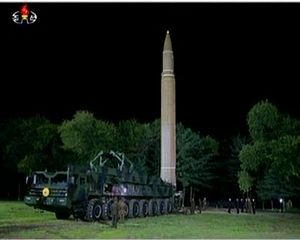On July 28, a little more than three weeks after its first-ever flight test of an intercontinental-range ballistic missile, North Korea carried out a second test. The missile launched at nighttime from near Jonchon in the heart of North Korea’s Chagang province, near a site known as Mupyong-ni.
The missile flew to an apogee of 3,700 kilometers, demonstrating the highest lofted apogee yet for a North Korean ballistic missile. Over a flight time of 47 minutes, it eventually descended and landed in the Sea of Japan, some 1,000 kilometers from its point of launch.
The trajectory, some experts assess, demonstrates a capability to strike U.S. east coast targets, depending on the missile’s eventual payload weight and other variables.
For the first time, more detail is available on the specifics of the Hwasong-14’s flight on the night of July 28. According to U.S. officials with knowledge of the test who spoke to The Diplomat, North Korea achieved the demonstrated trajectory by burning the missile’s liquid-propellant-based engines, which were configured differently in the second stage, for a different amount of time each than in the July 4 test.
In the July 28 test, the missile’s first stage burned for 151 seconds, a slight increase from the 145 seconds observed during the July 4 test. Moreover, the missile’s second stage burned for 224 seconds in the second test, a slight decrease from the 233 observed on July 4.
During the second Hwasong-14’s flight, the first stage engine was cut off at an altitude of 130 kilometers. The first stage reached an apogee of 703 kilometers before separating. The second stage engine was cut off at an altitude of approximately 750 kilometers.
In the days since North Korea carried out this second flight test of the Hwasong-14/KN20, U.S. officials have also revealed to The Diplomat that the ICBM was not entirely identical to the first missile tested on July 4. Critically, North Korea added yaw maneuvering motors to the missile’s second stage.
The yaw maneuvering motors likely involved the addition of two more vernier engines to the missile’s second stage to increase thrust while also increasing the rate of fuel consumption.
Though the second stage engine burn time was indeed lower in the second test, despite the greater overall performance, it does not appear that North Korea burned its fuel at a substantively faster rate.
The yaw maneuvering motors during the July 28 flight of the Hwasong-14 were not activated for the full duration of the engine’s burn time, but were used to steer the second stage “a few degrees to the left,” a source told The Diplomat.
Whither the Hwasong-14’s Reentry Vehicle?
The July 28 Hwasong-14’s reentry vehicle, meanwhile, remains the subject of public debate after a series of videos recorded in Hokkaido, Japan showed what appeared to be a glowing object falling into the Sea of Japan on the night of the test.
Michael Elleman of the International Institute for Strategic Studies and John Schilling of 38North, based on the video, have both expressed the view that, if the object in the video was indeed the missile’s reentry vehicle, it likely did not survive to splashdown successfully in the Sea of Japan.
Other experts, however, dispute the utility of the video in determining the success of the reentry vehicle’s performance during the July 28 test.
Given the unusually sharp and high loft, the reentry vehicle would have faced structural stresses during reentry that would be unlikely if it were fired on a minimum energy trajectory.
North Korea’s state-run Korean Central News Agency (KCNA) did not make a claim that the reentry vehicle survived the July 28 launch, but it did do so after the July 4 launch.
After the July 4 launch, KCNA noted that the reentry vehicle “accurately hit the targeted waters without any structural breakdown at the end of its flight.”
Despite this North Korean claim, U.S. officials have yet to evaluate the performance of the July 4 reentry vehicle fully; one source, nevertheless, told The Diplomat that a preliminary assessment suggested that the July 4 Hwasong-14 ICBM’s reentry vehicle may have survived to an altitude of 1 kilometer — performance that may be sufficient to deliver a 30 kiloton airburst nuclear weapon, similar to what North Korea is thought to have tested during its September 2016 nuclear test.
After the most recent launch, instead, KCNA clarified that the reentry vehicle faced conditions “harsher” than what it would encounter otherwise, suggesting that proving the reentry vehicle’s survival may not have been the paramount objective for this test.
Instead, demonstrating a longer flight range and operational pre-launch procedures appear to have driven this test.
After two tests, Kim Jong-un has not yet declared the Hwasong-14 ICBM to have reached initial operating capability, which suggests that further testing may be ahead.

































